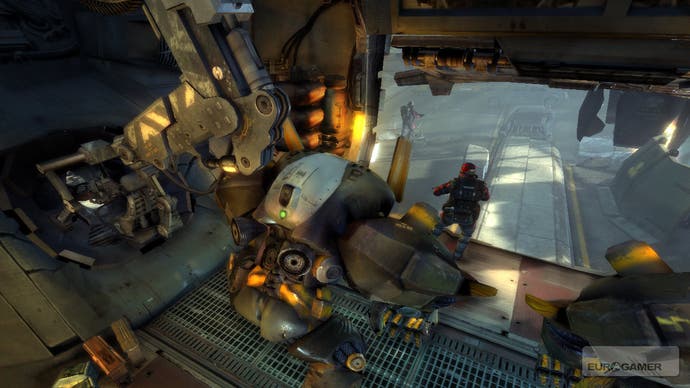Bionic Commando
Where the wild thing's arm.
Not that the game tries to leave you in any doubt about that once it gets going. The plank-brained grunts of the terrorist occupation force are barely worth the more elaborate ends you can put them to, but when they're reinforced by machinegunners, or deployed in greater numbers, they're sufficiently pesky to kill you. And it's in this way that developer GRIN aims to regulate the difficulty level: more enemies! Checkpointing is generally only worth the odd grumble, but there are a few real spikes, including a very frustrating battle in the FSA Archives building late on, where the enemy force goes through several waves of fiddly projectile-spitting fodder, which comes off as cheap - especially as it's merely the filling between not being able to access something and suddenly receiving authorisation. What tactical depth should be available is neutered by density.
Less frustrating, but more surprising, is that Bionic Commando never goes properly open-world, preferring a halfway house that offers freedom as far as the eye can see and then a slow radioactive death to dissuade you going any further. You're forever working your way to the next yellow checkpoint icon on the mini-map, which is often a relay beacon that disables aerial minefields, opening up the way to the next waypoint. There are a few hidden 8bit capsule-toy style icons to uncover per area, but between the orienteering and frequent load screens you come to accept that this is a corridor action game - it's just that the corridors are broad and nicely decorated.
And this they are, and only occasionally to the detriment of the frame-rate. Ascension City may be on its last legs (if not knees, or slumped over in a pool of its own effluent), but it's as imposing as Crackdown's Pacific City and as detailed, and in its haunting desolation and abandonment, almost as characterful as GTAIV. The haze is sometimes off-putting, and I do wish we didn't have to go inside or underground so much, but the water, lighting effects and sheer scale are achievements, particularly in areas like the glass-domed park and cavernous fissure running beneath the city.

There's variety too, as illustrated by the diversity of multiplayer playgrounds for the eight-player online games, within which you can gather for deathmatch and CTF variants. As you may have discovered in the recent Xbox Live demo, however, it's a dangerous place to tread if you're still a novice with the bionic arm, and a rudimentary lobby system also does a poor job of recommending it. Where it ultimately falls down though is in the relationship between players, which can't match the battles between a fully tooled Spencer and increasingly overpowered, Capcom-spec enemies in the single-player campaign.
By the time I reached the end of that campaign, I was experiencing mixed emotions. GRIN has certainly taken the load off combat boots wearied by too many open worlds with great effect, but although you travel over rather than along them, they are still highways of debris passing beneath your feet, and all you are doing is pausing occasionally to dispatch the people you meet and consult the A-to-Z. The result, though stylish and engaging, is something rather more primitive than the more enjoyable battles - where the bionic swing and core combat work in closest collaboration - really deserve. Bionic Commando succeeds in resurrecting a good idea lost to the Capcom archives, and giving it a new lease of life, but it falls foul of a few old standards in the process.


